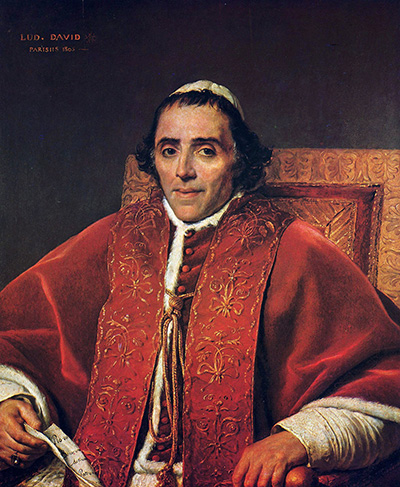Portrait of pope Pius VII, executed in 1805 by Jacques Louis David, is an oil-on-canvas painting of the supreme pontiff who reigned at the beginning of the 19th century.
Pious VII, who had crowned Napoleon I as Emperor of France in the year prior to the portrait's completion, had been elected at the turn of the century and had overseen a series of compromises between the Roman Catholic Church and the post-revolutionary French state. It is believed that David, a former student of François Boucher and Joseph-Marie Vien, was commissioned to paint the portrait by Charles Pierre Claret de Fleurieu. The painting, measuring 34 inches by 28 inches, is on display at the Louvre in Paris.
David, who had supported the Jacobins during the French Revolution and whose paintings at the time had demonstrated his political radicalism, was imprisoned for a time after the curtailment of revolutionary terror. The changing political climate in France, the reconciliation between the post-revolutionary state and the Roman Catholic Church, the nation’s rise to imperial glory as well as Napoleon I’s coronation all caused a shift in French painter’s attitudes. It was in this more moderate climate, in which anti-clerical zeal dissipated and traditional religion reemerged as a potent force in public life, that David created his three-quarter-length portrait of the pope.
Urban VII, seated before a dark-brown background, appears to be a man of middling years whose medium-length hair has yet to turn from black to grey. The ornate chair, covered in red velvet and embroidered with gold threat, appears to be one of the more expensive and ostentatious pieces of furniture in the papal collection and allows the supreme pontiff to demonstrate his high social status via a display of earthly riches. A white zucchetto, or papal cap, adorns the Bishop of Rome’s head while a red mozzetta with ermine cuffs is worn over his white rochet. A red stole, with intricate patterns embroidered in gold, is draped around the supreme pontiff’s shoulders while a piece of paper that is held in his right hand declares that he is a patron of the arts.
The pope, his dark eyebrows raised and the corners of his mouth raised in a slight smile, wears an affable expression on his face while his eyes seem to be looking over the viewer’s right-hand shoulder and watching something that only he can see. This knowing smile could indicate that the Bishop of Rome is concealing his true feelings, hiding his sincere opinions or that he may be in the possession of knowledge which he does not wish to share. The anti-clericism that had characterised the Reign of Terror, the French invasion of Italy and the Papal States as well as the arrest of Pius VII’s predecessor were recent memories at the time of the portrait’s creation.




